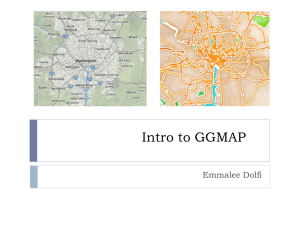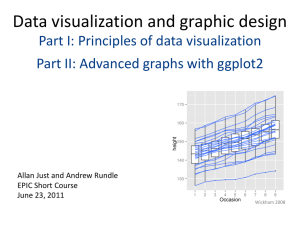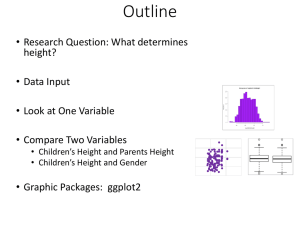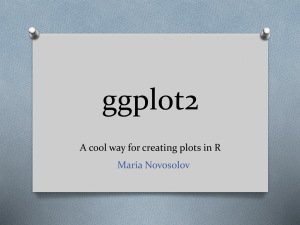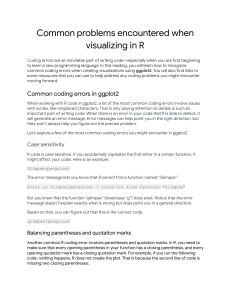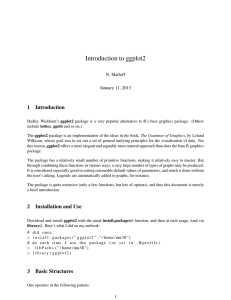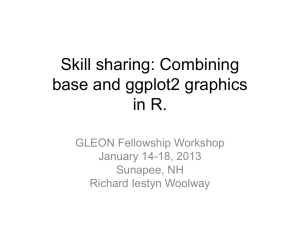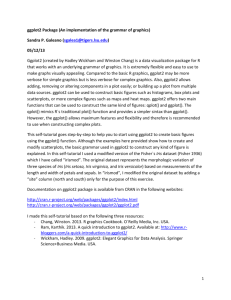Data
advertisement
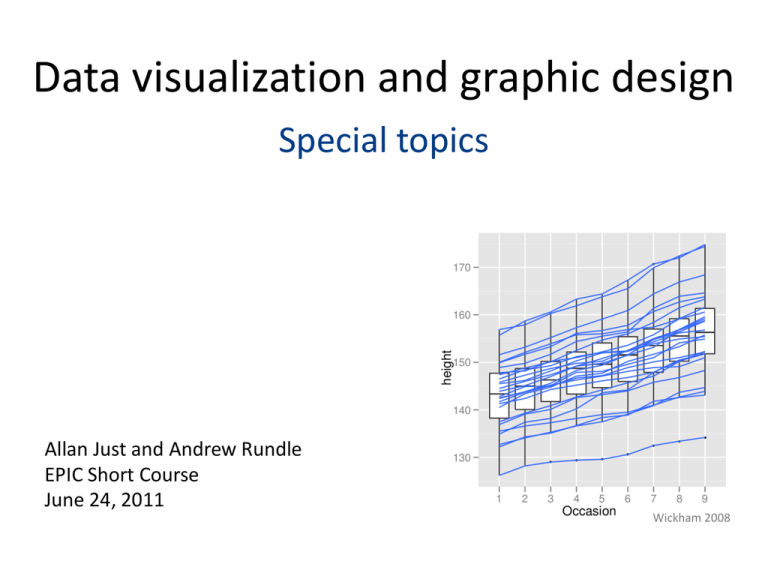
Data visualization and graphic design
Special topics
Allan Just and Andrew Rundle
EPIC Short Course
June 24, 2011
Wickham 2008
Quick hits
• Layer order in Deducer
• Bubble charts
• ggplot2 quasi-beanplot
Agenda
Being on your own with ggplot2 and R – getting unstuck
Small datasets revisited
Large datasets
Displaying uncertainty
Automated generation of many plots
Extending ggplot2 – direct labels and scatterplot matrices
New geoms
More practice exercises!
Wrap up
2
A theory about practice…
3
Getting unstuck…
• Check the str() of your data
• Check the console for error messages
• Look at the call for your plot – is that what you
wanted?
• Easier to start with something that works but is too
simple
1. Simplify the plot until it works
2. Add back components one-by-one to isolate the
problem
4
Reproducible examples and the
ggplot2 listserve
http://groups.google.com/group/ggplot2
Compose your question well and you might
figure out the answer in the process!
5
Loss of
information
Data + summary
6
Better than bar charts…
data(airquality)
# open the plot builder and add geom_point
# with x = Month and y = Ozone
Data + summary – building this ourselves…
7
Pseudo beanplots
g_violin_bean <- ggplot(sleep,
aes(x = extra)) +
geom_ribbon(aes(ymax = ..density.., ymin = -..density..), stat = "density", fill = "black") +
geom_segment(aes(y = -.05, yend = .05, xend = extra), color = "grey90") +
facet_grid(. ~ group, as.table = FALSE, scales = "free_y") +
opts(panel.margin = unit(0 , "lines")) + xlab(NULL) + theme_bw(base_size = 20) +
coord_flip() + opts(axis.text.x = theme_blank()) + expand_limits(x = c(-5, 9))
g_violin_bean
8
What about large datasets?
Playing with diamonds…
data(diamonds)
str(diamonds)
With your neighbor: how do we show the data
on the caret – price relationship…
10
Strategies for large datasets
– Use smaller points - use circles
– Use partial transparency
– Jitter (small random noise) if data take discrete values
– Overlay a smoother to show the trend
– Display a random sample from your data
11
How do you show 54,000 diamonds?
Partial transparency
Alpha = 0.01
Contours for density
Alpha = 0.1
Hexagonal bins
with legend
12
Displaying uncertainty
• Confidence intervals (uniformly shaded or
bounded)
• Pointwise errorbars
• Bayesian simulations
• Resampling based estimates
13
Model shouldn’t extend beyond the range of your data
14
xkcd.com/605/
15
16
17
Graph your uncertainty
Informal Bayesian Simulation
1.
Run regression
2.
Draw random numbers based on uncertainty of
your regression
ˆ n k / X
for X ~
2
nk
3.
Plot some lines!
4.
Uses the sim() function in package “arm”
Gelman and Hill 2007
18
Informal bayesian simulation
Figure 3. Association between DEP concentrations in personal air and the urinary metabolite MEP
concentrations (adjusted for specific gravity) stratified by perfume use using linear regression of log
transformed values. Lighter lines represent predictive uncertainty in regression parameters from
informal Bayesian simulations (20 simulation draws with uniform priors). Boxplots show the
19
distribution of MEP with means (“X”).
Just et al 2010
Resampling - Spline after bootstrap
20
Cosma Shalizi 2010
How random is random - the qq-plot
21
qqreference from package DAAG
a Q-Q envelope – show range from 19 draws of random normal
22
Venables and Ripley
Generating many graphs
Example: suppose we wanted to save a separate plot
of mileage for each car manufacturer in "mpg"
Start with data formatted so that it is long…
manufacturer cty hwy
1
audi 18 29
2
audi 21 29
25
chevrolet 15 23
26
chevrolet 16 26
100
honda 28 33
101
honda 24 32
Use the magic of
R and ggplot2…
23
Generating many graphs
Example: suppose we wanted to save a separate plot
of mileage for each car manufacturer in "mpg"
Start with data formatted so that it is long…
manufacturer cty hwy
1
audi 18 29
2
audi 21 29
25
chevrolet 15 23
26
chevrolet 16 26
100
honda 28 33
101
honda 24 32
• Use d_ply (from the plyr package – also by Hadley Wickham) to
split up the dataframe by our subsetting variable
• Define a function to run on subsets; we name these smaller
dataframes "dat"
• Call ggplot() and ggsave() within this function to generate and
save our plot
24
Generating many graphs
Example: suppose we wanted to save a separate plot
of mileage for each car manufacturer in "mpg"
# d_ply takes a dataframe, splits it apart, applies a function
d_ply(mpg, .(manufacturer), function(dat) {
# create a ggplot2 object named figure using 'dat'
figure <- ggplot(dat, aes(cty, hwy)) +
geom_smooth(method = "lm") +
geom_point(alpha = 0.7, size = 2.5,
position = position_jitter(height = 0.1, width = 0.1)) +
annotate("text", x = -Inf, y = Inf, hjust = -.1, vjust = 1.2,
label = paste("n =", nrow(dat))) +
opts(title = dat$manufacturer[1]) # unique title can help
# create a unique filename for each subset (e.g. "MPG_Audi.png")
filename <- paste("MPG_", dat$manufacturer[1], ".png", sep = "")
# by default this saves to your working directory; see ?getwd
ggsave(filename, figure, height = 6.5, width = 10)
})
25
Extending ggplot2
Let's get some more packages:
install.packages()
directlabels
GGally
26
Extending ggplot2: directlabels
27
# original code adapted from http://learnr.wordpress.com
library(ggplot2)
# define the dataset
df <- structure(list(City = structure(c(2L, 3L, 1L), .Label = c("Minneapolis",
"Phoenix", "Raleigh"), class = "factor"), January = c(52.1, 40.5,
12.2), February = c(55.1, 42.2, 16.5), March = c(59.7, 49.2,
28.3), April = c(67.7, 59.5, 45.1), May = c(76.3, 67.4, 57.1),
June = c(84.6, 74.4, 66.9), July = c(91.2, 77.5, 71.9), August = c(89.1,
76.5, 70.2), September = c(83.8, 70.6, 60), October = c(72.2,
60.2, 50), November = c(59.8, 50, 32.4), December = c(52.5,
41.2, 18.6)), .Names = c("City", "January", "February", "March",
"April", "May", "June", "July", "August", "September", "October",
"November", "December"), class = "data.frame", row.names = c(NA,
-3L))
#and season labels
seasons <- data.frame(month = c(1.5, 4.5, 7.5, 10.5),
value = 97, season = c("Winter", "Spring", "Summer", "Autumn"))
A fully polished plot
probably took a lot
of coding
# melt the dataset to a long format
dfm <- melt(df, variable_name = "month")
levels(dfm$month) <- month.abb
#build the basic plot
p <- ggplot(dfm, aes(month, value, group = City, colour = City))
p1 <- p + geom_line(size = 1)
dgr_fmt <- function(x, ...) { parse(text = paste(x, "*degree", sep = "")) }
none <- theme_blank()
p2 <- p1 + theme_bw() + scale_y_continuous(formatter = dgr_fmt, limits = c(0, 100), expand = c(0, 0)) +
xlab(NULL) + ylab(NULL) +
opts(title = expression("Average Monthly Temperatures (" * degree * "F)"),
panel.grid.major = none,
panel.grid.minor = none,
legend.position = "none",
panel.background = none,
panel.border = none,
axis.line = theme_segment(colour = "grey50"))
(p3 <- p2 + geom_vline(xintercept = c(2.9, 5.9, 8.9, 11.9), colour = "grey85", alpha = 0.5) +
geom_hline(yintercept = 32, colour = "grey80", alpha = 0.5) +
annotate("text", x = 1.2, y = 35, label = "Freezing", colour = "grey80", size = 4) +
geom_text(data = seasons, aes(label = season, group = NULL), colour = "grey70", size = 4))
(p4 <- p3 + geom_text(data = dfm[dfm$month == "Dec", ], aes(label = City), hjust = 0.7, vjust = 1))
data_table <- ggplot(dfm, aes(x = month, y = factor(City), label = format(value, nsmall = 1), colour = City)) +
geom_text(size = 3.5) + theme_bw() +
scale_y_discrete(formatter = abbreviate, limits = c("Minneapolis", "Raleigh", "Phoenix")) +
xlab(NULL) + ylab(NULL) +
opts(panel.grid.major = none,
legend.position = "none",
panel.border = none,
axis.text.x = none,
axis.ticks = none,
28
Extending ggplot2: GGally
Scatterplot matrix: 36 plots showing ~9K measures
bivariate densities and correlations
29
30
Making a scatterplot matrix
library(GGally)
data(iris)
head(iris[, 3:5]) #iris columns 3 to 5
# example 1 - defaults
ggpairs(iris[, 3:5])
# example 2 – more customized by data type
ggpairs(iris[,3:5],
upper = list(continuous = "density", combo = "box"),
lower = list(continuous = "points", combo = "dot"),
diag = list(continuous = "bar", discrete = "bar"))
# example 3 – some new stuff!!!
dat <- data.frame(x = rnorm(100),
y = rnorm(100),
z = rnorm(100))
plotmatrix <- GGally::ggpairs(dat,
lower = list(continuous = "density",
aes_string = aes_string(fill = "..level..")),
upper = "blank")
plotmatrix
#EOF
31
Thinking about some new geoms
32
Showing density surfaces
from stat_density2d
Let's make a plot of x and y from data.frame dat
with stat_density2d
What is the default geom?
In the previous plot, which aesthetic was
showing those colors?
What geom would we need to make that plot?
33
geom_rug to show marginal distribution
34
35
36
37
38
geom_polygon after computing the convex outer hull,
labels at the centroids, moved the legend to the top
39
40
“Hey, what did you learn in that EPIC class you took?”
41
Recap: Why we did this
Visualization is important for communicating
information and promoting your ideas
Effective designs will be noticed
We make many graphs quickly for discovery
and choose the best ones to polish for communication
With a theory of visualization we can create
sophisticated graphics using basic components
42
Recap: Designing a good scientific figure
1. Answer a question – usually a comparison
2. Use an appropriate design (emphasize comparisons
of position before length, angle, area or color)
3. Make it self-sufficient (annotation & figure legend)
4. Show your data – tell its story
Recap: ggplot2 and R
R is a powerful language for statistics and data analysis
ggplot2 implements a “grammar of graphics”
ggplot2: Builds plots using data,
and layers of geometric objects,
mapping variables to aesthetic features,
which have been transformed by scales,
summarized with statistics,
projected into a coordinate system,
and subset into adjacent plots with facets
44
Recap: JGR and Deducer
JGR: a graphic interface system for R programming
Deducer: adds menu driven analysis and plotting
45
Deducer: Plot Builder
Save or import
.ggp file
View call to see R code
Send R code to Console
ggsave("plot.png", height = 6.5, width = 10)46
Deducer: Plot Builder
Right-click
to Get info
Right-click to edit, Adjust position
Stat
toggle, remove
Data
Mapped
vars
Geom
More options
by component
Switch to map
to a var
Set to a constant
value
Order of drawing layers
47
Questions?
acj2109@columbia.edu
